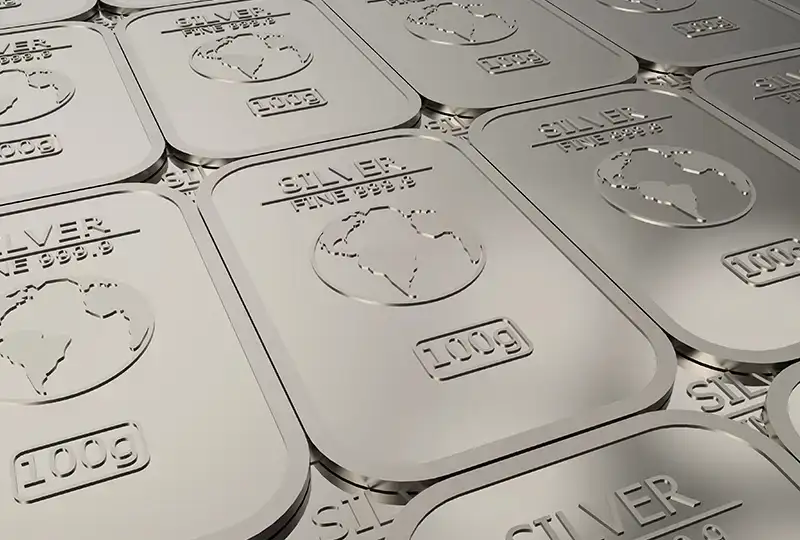What is Bullion?
What makes bullion, bullion? Bullion refers to gold, silver, platinum, or palladium that’s officially certified as high-purity precious metal mass-produced into transportable, tradable products like bars or minted coins for global investing and commerce. Refiners verify fineness through exacting testing techniques. This validated high quality gives bullion its recognizable, inherent value that banks, governments, and everyday prosperity-seekers can rely on.
We deal exclusively in hallmark bullion from the most trusted mints worldwide so North Dakota collectors and stackers never have to question asset authenticity or overpay. Contact Minot Coin today so we can explain our latest bullion arrivals further and guide eager buy-side investors.
Key Bullion Features
High purity.
For gold, it must be at least 99.5% pure gold, and for silver, at least 99.9% pure silver. This ensures its inherent value.
Mass-produced.
Bars and coins are manufactured by mints and refineries in large quantities to meet investing demand. This makes for easy purchase and sale.
Priced near “spot” value.
The bullion price closely correlates to the prevailing spot market prices for gold or silver, with low premiums over the spot.
Bullion distills precious metals into standardized bars and coins convenient as assets due to purity verification and intrinsic worth. Wide adoption also lends bullion inflation protection and shields portfolios from market risks.
What is Gold Bullion?
Gold bullion refers to physical gold meeting the 99.5% minimum purity designation for authenticity. These verified assets take the form of standardized bars, ingots, or minted coins ready for secure trade and long-term holding. Major financial players like central banks traffic gold bullion to underpin enormous transactions and stabilize national treasuries. For individual investors, high-purity gold bullion serves as an enduring, transportable store of tangible wealth thanks to gold’s proven ability to maintain purchasing power over centuries.
Gold Bars
These are produced by refineries or mints in various sizes from 1 gram up to 400 ounces. They may be further classified as cast, hand-poured, or minted bars.
Gold Coins
These are special commemorative coins made of gold by government mints with a legal tender face value, struck in weights typically ranging from 1/10 oz to 1 oz coins. Popular global gold coins investors desire the American Gold Eagle, Canadian Gold Maple Leaf, and Australian Gold Kangaroo.
Gold Rounds
These are similar to coins but without legal tender status and produced by private mints, usually at lower premiums over gold spot price than official gold coins. Come in one-troy ounce and fractional sizes.

People invest in gold bullion because gold has historically held its value well over long periods. Owning physical gold coins and bars can protect your money against things like inflation, volatile markets, and political changes. Gold tends to keep its buying power through different economies.
What is Silver Bullion?
Silver bullion means pure silver officially testing at least 99.9% that’s held as bars, ingots, or coins mainly for investing to store value over time.
Silver Bars and Ingots
Produced by private or government-operated mints in various sizes from 1 gram to 1,000 ounces. It may come in basic shapes or detailed designs. Popular among individual investors.
Silver Bullion Coins
Special collector coins made of silver by government mints, struck in sizes from one ounce to fractional coins, with a legal tender face value. Top global coins sought by investors include the American Silver Eagle, Australian Silver Kangaroo, Canadian Silver Maple, etc.
Silver Rounds
Privately minted silver discs in one troy ounce or fractional sizes, without legal tender status. Usually carry lower premiums over spot silver price than official coins.

Silver costs less than gold but moves up and down more in price. It gets used in industry, so demand changes. Adding some silver to investments can help balance risk during unstable economies. Silver remains popular for its value and versatility.
What is Platinum Bullion?
Platinum bullion means pure platinum officially testing 99.95% fineness. It gets held as bars, ingots, or coins mostly to store value for investors over time.
High purity standards
Must be .9995 pure platinum to qualify as bullion. This ensures its inherent and resale value.
Platinum Bars and Ingots
Mass-produced by refiners and mints in various sizes from 1 gram up to 100 oz. Allow convenient storage and transport.
Platinum Bullion Coins
Special platinum coins struck by government mints in set weights like 1/10 oz and 1 oz, with a legal tender face value.
Platinum Pricing
Trades at prevailing platinum spot prices plus a small premium from the manufacturer.

Platinum occurs less than gold or silver. Adding some platinum bars or coins can spread out risk in investments. Its long-lasting shine and worth shoulders against inflation bumps and financial storms over decades.
Get Our Latest on YouTube.
Stay updated with our newest precious metal arrivals, deals, and announcements by following the Minot Coin YouTube channel! Subscribers are first to know about inventory updates like fresh bullion and coin arrivals. For exclusive access, hit the “Subscribe” button below.